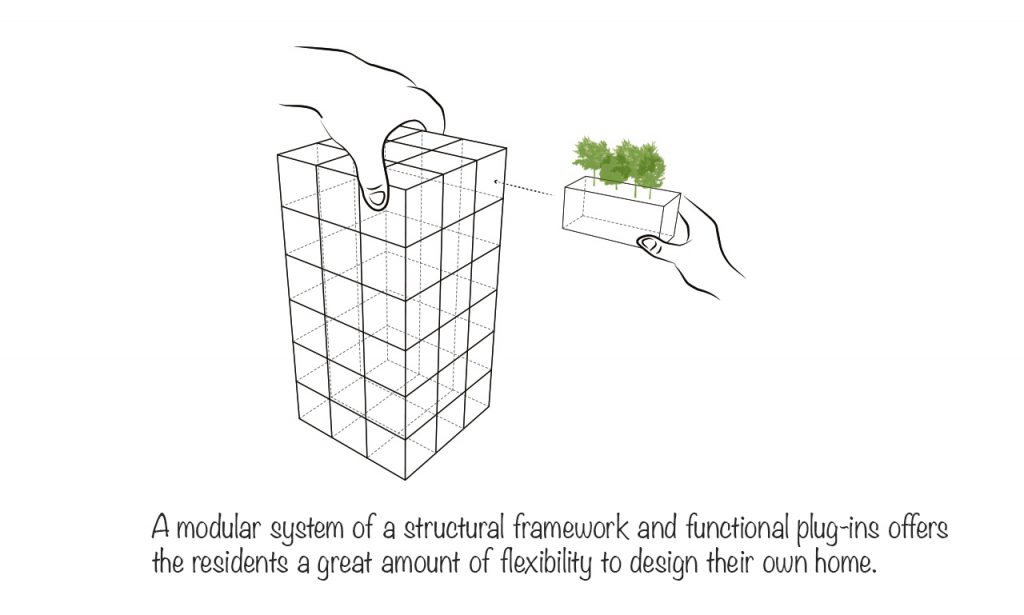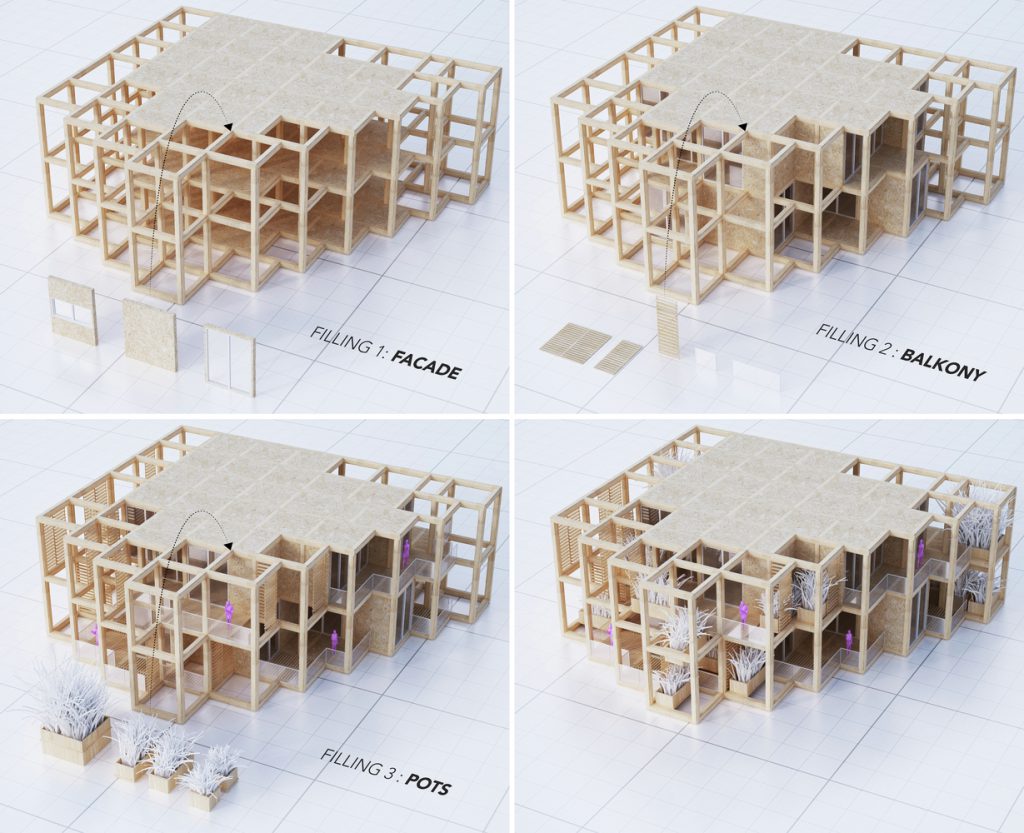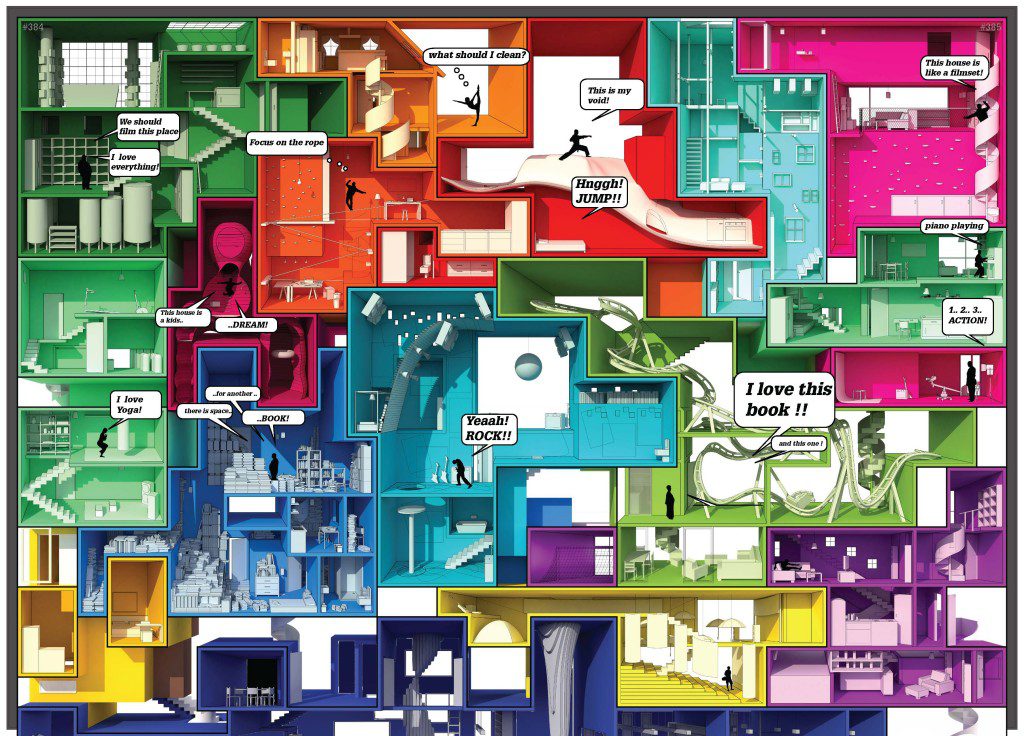Readdressing Individualism in Hong Kong Residential Developments
|
Thesis Statement Housing, the type of architecture with the most intimate relationship with human, should address more originality and individuality by providing freedom of customization instead of being isolated from human lives with a stereotyped and standardized design. Context / Ideas / Precedents In an age of mass production, Residential Towers has unfortunately become a standardized and unindividualized design product. Although more than a century has passed since the second industrial revolution, the residential developments in Hong Kong still take on a boxy concrete form of Modernism. The architecture that is the most close with human lives, now addresses no human concern due to a certain conformism in the building industry and the pursuit of economy maximization. This situation has already aroused architects’ attention. Early in 1960s, Metabolists in Japan proposed an idealistic concept to solve the contradiction between massification and individuality by envisaging a spatial urbanism allowing inhabitants to build their own house within a big infrastructural framework. This concept was seen naive without mature technologies or practical details at that time. However, the idea is inherited and being replenished.  Fig.1. penda, Demonstration of the Modular system. Available from: http://www.archdaily.com/772181/penda-to-build-modular-customizable-housing-tower-in-india/55d4e15ae58ece20e9000147-penda-to-build-modular-customizable-housing-tower-in-india-photo
The Pooja Crafted Homes done by Penda is one of the recent examples that demonstrated a similar concept of mass customization. The structural frame and the infrastructure is the only fixed elements. The residents are offered a catalog of pre-fabricated units of façade, balcony, floor and roof to choose from. These customized elements would give each house its unique character and also allow future modifications. However, the space here to each family is almost equally distributed and there is no potential to expand or to shrink in the future.  Fig.2. penda, Module Compositions. Available from: http://www.archdaily.com/772181/penda-to-build-modular-customizable-housing-tower-in-india/55d4e181e58ece20e9000148-penda-to-build-modular-customizable-housing-tower-in-india-photo The studio in TuDelft had a even more radical idea when they were doing a project called “Egocity”. The architectural students basically only give the boundary of the building and decide the number of residents in this building. The distribution and organization of space in this building is done by the inhabitants themselves with a series of bargain, trading-off and compromise. The self-organization process is simulated with grasshopper under certain principles. The results varied when they use different principles. The scale of the building here is only for 17 inhabitants, however, the situation in HK would make this simulation much more complicated and this method would not have the potential to be widely applied. Besides the concern for individuality in a fixed moment, there also comes the idea of impermanence and movability when we look into the timeline. The requirements of people towards housing change with the changing number of family members, the fluctuating financial circumstances, and the transformation of their life attitudes, etc. When a baby in a family grows up, he might want his own room, and when a child goes study abroad, there would be spare space. These changes usually result in people spending lots of time, energy and money moving to new apartments or make them compromise with the non-ideal situation. Thus, if the apartment units could grow or shrink according to different needs, it would achieve maximum efficiency.
Project Description This Thesis project aims to bring individualism and originality into Hong Kong residential developments by exploring the potential trading-off between inhabitants when they were given the opportunity to modify the space boundary between neighborhood. Principles and guidelines would be made to constraint and normalize this process of self-space organization.
Methodological Process
Bibliography Lin, Zhongjie. Kenzo Tange and the Metabolist Movement, Urban Utopias of Modern Japan. London and New York: Routledge, 2010. Koolhaas, Rem., and Obrist, Hans Ulrich. Project Japan, Metabolism Talks. Cologne: TASCHEN, 2011. Wu, Xianghua. “Concrete Resistance: Ando in the context of critical regionalism.” Accessed Nov 4, 2016 http://docslide.us/documents/case-study-of-tadao-ando.html Archdaily. “penda to Build Modular, Customizable Housing Tower in India.” Last modified Aug 19, 2015. http://www.archdaily.com/772181/penda-to-build-modular-customizable-housing- The Creators Project. “ This Modular Tower Concept Looks Like A Giant Jenga.” Last modified Jan 6, 2012. http://thecreatorsproject.vice.com/blog/this-modular-tower-concept-looks-like-a- Block’Hood. “Trailer.” Accessed Nov 4, 2016. http://www.plethora-project.com/blockhood/
|

One Comment